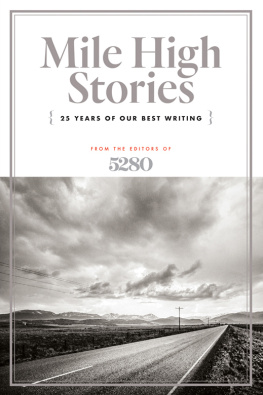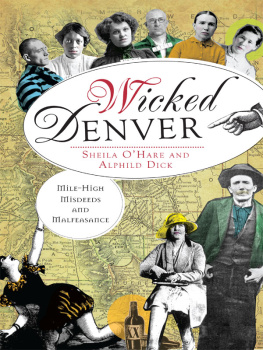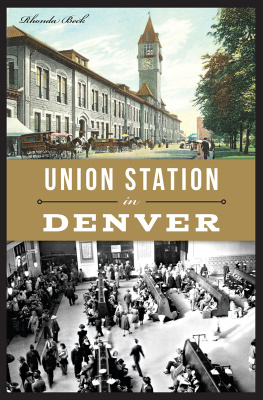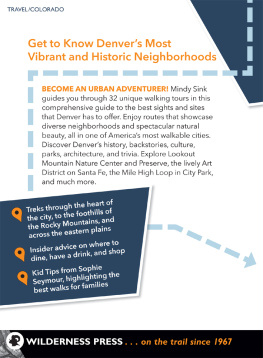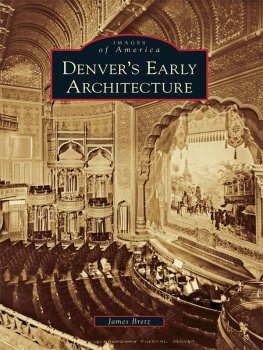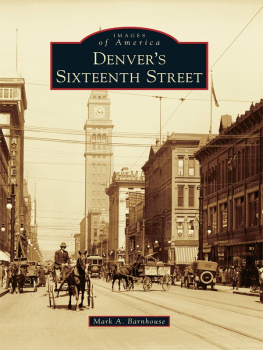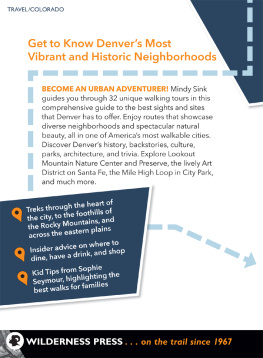Metropolitan DenverMETROPOLITAN PORTRAITS
Metropolitan Portraits explores the contemporary metropolis in its diverse blend of past and present. Each volume describes a North American urban region in terms of historical experience, spatial configuration, culture, and contemporary issues. Books in the series are intended to promote discussion and understanding of metropolitan North America at the start of the twenty-first century.
Judith A. Martin, Series Editor
Metropolitan Denver
Growth and Change in the Mile High City
Andrew R. Goetz
and
E. Eric Boschmann
Copyright 2018 University of Pennsylvania Press
All rights reserved. Except for brief quotations used for purposes of review or scholarly citation, none of this book may be reproduced in any form by any means without written permission from the publisher.
Published by
University of Pennsylvania Press
Philadelphia, Pennsylvania 19104-4112
www.upenn.edu/pennpress
Printed in the United States of America on acid-free paper
10 9 8 7 6 5 4 3 2 1
Library of Congress Cataloging-in-Publication Data
Names: Goetz, Andrew R., author. | Boschmann, E. Eric, author. Title: Metropolitan Denver : growth and change in the Mile High City / Andrew R. Goetz and E. Eric Boschmann. Other titles: Metropolitan portraits.
Description: 1st edition. | Philadelphia : University of Pennsylvania Press, [2018] | Series: Metropolitan portraits | Includes bibliographical references and index.
Identifiers: LCCN 2018002981 | ISBN 978-0-8122-5045-9 (hardcover : alk. paper)
Subjects: LCSH: Denver (Colo.)History. | Denver (Colo.)Economic conditions21st century. | Denver (Colo.)Social conditions21st century. | Regional planningColoradoDenver. | Human geographyColoradoDenver.
Classification: LCC F784.D457 G64 2018 | DDC 978.8/83dc23
LC record available at https://lccn.loc.gov/2018002981
Contents
Perhaps no city symbolizes the American West more than Denver, Colorado. It was founded in 1858 during the Pikes Peak gold rush, and its origins and early growth were tied to mining, railroads, agriculture, and cattle ranching. It has grown in step with the growth of the West from frontier outpost to major metropolis, driven by an economic base in the energy, defense, aerospace, government, telecommunications, information technology, medical, tourism, and recreation industries. Its proximity and orientation to the Rocky Mountains has provided Denver with its essential identity as the Mile High City, where the blending of Old West imagery and New West reality is on full display.
As we contemplated our approach to creating a portrait of metropolitan Denver in this book, the themes of growth and change emerged as the dominant story line. While growth and change are evident for virtually all metropolitan areas, they are especially relevant for Denver, with its history of extreme boom-and-bust cycles, including its current major boom. Grappling with growth and its challenges are an ever-present concern, and the lessons of Denvers experiences have significance for other cities that are faced with extreme growth pressures. The purpose of this book, therefore, is to capture an image of contemporary Denver through its interrelated human, social, economic, and physical landscapes and to provide a geographic perspective on growth and change in the Mile High City.
Among large urban places in the United States, Denver has been one of the top three fastest growing from 2010 to 2016. For cities over 500,000 in population, Denvers rate of growth trails only Austin and Seattle. For metropolitan areas over 2.5 million, only Houston and Dallas had faster growth. And for combined statistical areas over 3 million, Houston, Orlando, and Denver were the fastest growing. Denver has become a destination of choice for millennials, consistently ranking as one of the top metro areas for in-migration among eighteen- to thirty-four-year-olds. Outdoor recreation, especially skiing, snowboarding, camping, hiking, and rafting, are major attractions, in addition to a vibrant arts and music scene, a thriving microbrewing industry, and the recent legalization and growth of the recreational marijuana business.
The current wave of growth has created significant challenges, especially affordability, equity, mobility, and sustainability. The rapid influx of population has increased demand for housing, but supply has not kept pace, leading to sharply increased prices for houses and apartments. Demand for housing in the city of Denver has resulted in neighborhood gentrification and displacement of lower-income residents who can no longer afford the higher rents or property taxes. Increased population has led to more traffic congestion and demands for improved transportation infrastructure. Expanding urbanization has contributed to urban sprawl and increased pressure on resource consumption and impacts on the natural environment. Denver is trying to address some of these concerns through a smart growth strategy emphasizing the development of higher-density pedestrian- and biking-oriented urban centers served by an expanding rail transit system. While some progress has been achieved, many of the growth challenges still remain.
We hope that this exploration of Denvers past and contemporary identity sheds new light on what the poet Walt Whitman first described as this curiously attractive region.
The headline of the Denver Post on September 18, 2015, read: Denver is flourishing. In fact, the beginning of the twenty-first century marks a high point in the history of Denver, Colorado. Population is booming, with a diverse influx of young millennials, older baby boomers, and new immigrants from across the globe. The region has a strong and diversified economy, resulting in rising median household incomes that are 25 percent higher than the national average, and a local poverty rate and unemployment rate well below national averages.
A variety of reasons might help explain why Denver seems to be flourishing. Denver has benefited from strong civic leadership, an early and successful spirit of entrepreneurialism, a legacy of charitable philanthropy, a favorable location with proximity to an abundance of natural resources, an enviable mild and sunny climate, quick access to mountain-based recreation, and successes in regional collaboration, including planning for future urban growth.
But at the same time Denver has also experienced many challenges, some quite common to other growing cities. Economic inequalities and social segregation have persisted, and communities have been marginalized or displaced. Rapid population growth is sprouting ongoing traffic congestion and sprawl, and metropolitan political fragmentation stymies regional progress on pressing issues. Air pollution has spoiled the regions crisp, clean air; surrounding land degradation is resulting from overuse for resource extraction and agriculture production; and urban development is encroaching into nearby open space, which continues with ongoing growth.
These successes and challenges are both Denvers legacy and its future. The purpose of this book, therefore, is to capture an image of contemporary Denver through its interrelated human, social, economic, and physical landscapes. In doing so, we also trace historical elements that centrally play into the identity of what Denver is today. In short, the guiding questions are: What is Denver today in regards to its people and culture, its economy and politics, and its environment and resources? And how did it historically evolve? Such a project could be approached using themes, perspectives, and story lines as diverse as the city itself. And many Denver-focused books have been written from a variety of important angles. This book uses a geographic perspective to illuminate the changes in both space and time of the citys spatial dimensions, place identity, human interactions with the natural environment, and social, economic, and political relations that shape the varied human landscapes in Denver and its surrounding communities.


